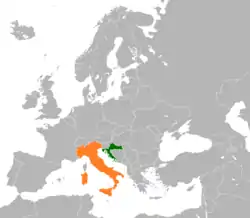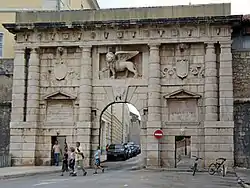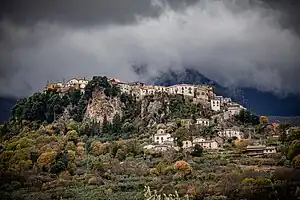 | |
Croatia |
Italy |
|---|---|
| Diplomatic mission | |
| Embassy of Croatia, Rome | Embassy of Italy, Zagreb |
The foreign relations between Croatia and Italy are bound together by shared history, geography, and kinship ties that reach back thousands of years, including kindred, ancestral lines. Modern relations commenced in 1992, following the dissolution of Yugoslavia and the independence of Croatia. Relations are warm and friendly with robust bilateral collaboration.[1][2] The two nations have strong connectivity through tourism, immigration, foreign aid, and economic mutualism.
Through their shared history, geographic and cultural delineations have commingled via nation-building dating back to the Roman Empire. This has led to historic cultural diffusion and created perennial tension around the italianità ("Italianness") of Croatia. Italian is an official language in Istria County (in Croatia), while Molise Croats inhabit in the Italian city of Campobasso. The close multiculturalism between Croatia and Italy is broadly popular and favored domestically. Croatia and Italy are close military allies, especially through their naval and coastal forces, with membership in NATO. They share a 370 nautical-mile maritime border over the Adriatic Sea, with a small 12 mile region of Slovenia separating them by land.
Both countries are members of the European Union and Council of Europe, sharing the same official currency, the euro (€). Croatia has an embassy in Rome and general consulates in Milan and Trieste while Italy maintains an embassy in Zagreb and a general consulate in Rijeka, among other cultural organizations.
History

Italy and Croatia, due to their geographic proximity, have shared a rich and complex history reaching back to the Roman Empire, of which they were both apart.[3][4] Northeast Italy and Northwest Croatia were combined by Roman emperor Augustus into Venetia et Histria from 7 AD–292 AD.[5][6] During the reign of Roman emperor Hadrian from 117 to 138, most of modern Italy and Croatia remained separate and constituted the historic regions of Italia and Dalmatia, respectively.[7] Croatia's Dalmatian coast was part of the Republic of Venice from 1409 to 1797, known then as Venetian Dalmatia.[8] After the fall of the Republic of Venice, the Treaty of Campo Formio transferred the region to the Austrian Habsburg Empire as the Venetian Province.[9] The Venetian Republic was an independent state until it merged with other regional republics during the mid-1800s to form the Kingdom of Italy.[10] Croatia is considered Italy's strongest historical partner within the Slavic world. Unlike other Slavic countries, Croatia shares Italy's dominant religion – Roman Catholicism. Croatian towns and cities near Italy have historically spoken Italian. During their respective nation-building during the 19th century, their relations were favorable.[11] Tensions emerged during World War II in Italy, after the rise of Benito Mussolini led to a full-scale invasion of Croatia.[11] Native Croatians were forced to italianize, with Italy exerting direct control of the short-lived Governorate of Dalmatia in 1941. Yugoslav communist revolutionary Josip Broz Tito repelled the Italians out of Croatia and counter-invaded part of Italy.[11] 350,000 Italians were forced to leave their native lands after the Yugoslav reprisal invasion.[11] The eventual dissolution of Yugoslavia during the 1990s, normalized relations between Croatia and Italy. Following Croatia's independence from Yugoslavia, Italy reestablished relations in 1992.[11] Italy was a key partner to Croatia following its statehood, providing critical political and economic support during the 2000s.[12] In 2007, Italy's president Giorgio Napoletano strained diplomatic relations by calling Croatia's expulsion of Italians during World War II, the "barbarism of the century".[13] Croatian president Stjepan Mesić accused Napoletano of historical revisionism but the nations' diplomats quickly resolved the matter in Rome.[14]
Italy supported Croatia's admission to the European Union in 2013. A diplomatic row emerged between the two states in 2019, after Antonio Tajani, the President of the European Parliament, commented "Long live Trieste, long live Italian Istria, long live Italian Dalmatia, long live Italian exiles".[15] Tajani later apologized to the Croatian government clarifying his comments were not intendeted to imply that the Istrian and Dalmatian regions of Croatia where apart of Italy.[16] In 2023, after a decade of strong economic activity, Italy became Croatia's most important trading partner with a 45% increase since 2021, according to Tajani.[17] That year, the two nations signed a tri-party agreement with Slovenia to ease immigration in Southest Europe.[18] Italy helped return a rare and "extremely valuable" 14th-century religious cross to Croatia, after a private citizen inadvertently bought it during an auction in London.[19]
Population
There are around 19,500 people of Italian descent living in Croatia. There are also around 6,000 Molise Croats in Italy. In addition, there are around 21,000 registered immigrant Croatian workers in Italy.[20] Italian is an officially-recognized language in Croatia, with the majority of its speakers living in Istria County. Dalmatian Italians historically constituted a significant population of Dalmatia. Italian is a popular foreign language in Croatia, with 15% of Croatians able to speak it well enough to have a conversation, according to Eurobarometer.
Trade
The two states share multiple bilateral free-trade agreements. Croatia exports around 14% of their total total annual export to Italy. [21] Trade between the two states totaled €8.64 billion in 2023, reaching an all-time high.[17]
Fishing
Croatia and Italy both maintain exclusive economic zones over the Adriatic Sea. Italy disputed the reach of Croatia's zone around the Italian part of the Adriatic in January 2008 claiming it violated an earlier agreement they made over "Ecological and Fisheries Protection Zones".[22] The two states mutually settled the dispute later that year.[22] This zone is supervised by the Croatian Navy, which intercepted two Italian ships in 2008 and 2021, seizing their illegal fish, and escorting them back to Italian waters.[23][24]
Consulates
Croatia has an embassy in Rome, general consulates in Milan and Trieste, and consulates in Bari, Florence, Naples, and Padua.[25] Italy has an embassy in Zagreb, general consulate in Rijeka, Vice Consulate in Buje, Pula and Split, as well as Italian Cultural Institute and Foreign Trade Institute in Zagreb.[26]
Sister cities
Croatia and Italy share a large number of sister cities between themselves.[27][28] Many of these cities have Croatian and Italian-language versions of their name due to historic cultural diffusion.


 Biograd and
Biograd and  Porto San Giorgio
Porto San Giorgio Bjelovar and
Bjelovar and  Ascoli Piceno /
Ascoli Piceno /  Rubiera
Rubiera Crikvenica and
Crikvenica and  Verbania
Verbania Dubrovnik and
Dubrovnik and  Venezia /
Venezia /  Ragusa /
Ragusa /  Ravenna
Ravenna Karlovac and
Karlovac and  Alessandria
Alessandria Križevci and
Križevci and  Reana del Rojale
Reana del Rojale Labin and
Labin and  Carbonia /
Carbonia /  Manzano /
Manzano /  Sospirolo
Sospirolo Lipik and
Lipik and  Abano Terme
Abano Terme Matulji and
Matulji and  Castel San Pietro Terme
Castel San Pietro Terme Medulin and
Medulin and  Montecarotto /
Montecarotto /  Porto Tolle
Porto Tolle Novigrad and
Novigrad and  Sacile
Sacile Omiš and
Omiš and  San Felice del Molise
San Felice del Molise Opatija and
Opatija and  Carmagnola /
Carmagnola /  Castel San Pietro Terme
Castel San Pietro Terme Osijek and
Osijek and  Vicenza
Vicenza Pag and
Pag and  Carbonera /
Carbonera /  Zanè
Zanè Poreč and
Poreč and  Massa Lombarda /
Massa Lombarda /  Monselice /
Monselice /  Segrate
Segrate Pula and
Pula and  Imola /
Imola /  Verona
Verona Rijeka and
Rijeka and  Este /
Este /  Faenza /
Faenza /  Genoa /
Genoa /  Trieste
Trieste Samobor and
Samobor and  Parabiago
Parabiago Šibenik and
Šibenik and  Civitanova Marche /
Civitanova Marche /  Muggia /
Muggia /  San Benedetto del Tronto
San Benedetto del Tronto Slunj and
Slunj and  Castel San Giovanni
Castel San Giovanni Split and
Split and  Ancona
Ancona Tisno and
Tisno and  Bucine
Bucine Trogir and
Trogir and  Montesilvano /
Montesilvano /  Porto Sant'Elpidio /
Porto Sant'Elpidio /  Tione di Trento
Tione di Trento Varaždin and
Varaždin and  Montale
Montale Vinkovci and
Vinkovci and  Camponogara
Camponogara Zadar and
Zadar and  Ancona /
Ancona /  Padua /
Padua /  Reggio Emilia
Reggio Emilia Zagreb and
Zagreb and  Bologna /
Bologna /  Molise
Molise
Football rivalry
Both Italy and Croatia share football as a national sport and have developed a friendly rivalry. Matches between them are known as Adriatic Derbies (Croatian: Jadranski derbi, Italian: Derby Adriatico) after the Adriatic Sea that separates the two nations.[29][30][31] Croatia has never lost against Italy, with most fixtures played in qualifications and at tournament.[32][33] The two sides have competed in the qualifiers and group stages of Euro 1996, Euro 2012 and Euro 2016 with multiple incidences of crowd trouble and flares being thrown onto the pitch.[34][35] They have only met at the 2002 World Cup, in a group stage match where Croatia came from behind to beat Italy 2–1, after two Italian goals were controversially disallowed.[36] This rivalry can be confused with the similarly named Adriatic derby between Croatian clubs Hajduk and Rijeka.
See also
References
- ↑ "Croatia in Europe Through the Ages: Croatian-Italian relations". Croatian Ministry of Foreign and European Affairs. 22 December 2023. Retrieved 22 December 2023.
- ↑ "Croatia-Italy economic cooperation at all-time high: Italy Croatia's number one trade partner". template.gov.hr. Retrieved 2023-12-24.
- ↑ "Croatia - Medieval, Adriatic, Balkans | Britannica". www.britannica.com. Retrieved 2023-12-24.
- ↑ Leocha, Charles (2006-08-03). "Never heard of Istria? Well, you will". NBC News. Retrieved 2023-12-24.
- ↑ BISPHAM, EDWARD (2007). "Pliny the Elder's Italy". Bulletin of the Institute of Classical Studies (100): 46. JSTOR 43767660. Retrieved 14 January 2021.
- ↑ Berto, Luigi (2013). ""Venetia (Venice)": Its Formation and Meaning in the Middle Ages" (PDF). NeMLA Italian Studies. 35: 1–2. Retrieved 14 January 2021.
- ↑ Barnes, Constantine: Dynastyr, Religion and Power in the Later Roman Empire, p. 160, 2011
- ↑ Zekan, Mate (1990). Kralj Zvonimir - dokumenti i spomenici [King Zvonimir - Documents and Monuments] (in Croatian and English). Zagreb: Muzej hrvatskih arheoloških spomenika Split, arheološki muzej Zagreb. p. 9–24.
- ↑ Budak, Neven (2018). Hrvatska povijest od 550. do 1100 [Croatian history from 550 until 1100]. Leykam international. p. 231–233, 248–267, 286–293. ISBN 978-953-340-061-7.
- ↑ Riall, Lucy (1994). The Italian Risorgimento: state, society, and national unification (First ed.). London: Routledge. p. 1. ISBN 978-0-203-41234-3.
The functional importance of the Risorgimento to both Italian politics and Italian historiography has made this short period (1815–60) one of the most contested and controversial in modern Italian history
- 1 2 3 4 5 Magaš, Branka (2007). Croatia Through History: The Making of a European State. Saqi. ISBN 978-0-86356-775-9.
- ↑ "Italy-Croatia: concert in Zagreb to mark the anniversary of diplomatic relations – Ministero degli Affari Esteri e della Cooperazione Internazionale". www.esteri.it. Retrieved 2023-12-24.
- ↑ Traynor, Ian (2007-02-13). "Italy and Croatia reopen old war wounds". The Guardian. ISSN 0261-3077. Retrieved 2023-12-24.
- ↑ Traynor, Ian (2007-02-13). "Italy and Croatia reopen old war wounds". The Guardian. ISSN 0261-3077. Retrieved 2023-12-24.
- ↑ Barigazzi, Jacopo (2019-02-11). "Slovenian, Croatian leaders accuse Tajani of 'historical revisionism'". POLITICO. Retrieved 2023-12-24.
- ↑ "Cerarja Tajanijevo opravičilo ni prepričalo. Tajanija k odstopu poziva tudi NSi". rtvslo.si (in Slovenian). 2019-02-12. Retrieved 2019-02-12.
- 1 2 "Croatia-Italy economic cooperation at all-time high: Italy Croatia's number one trade partner". template.gov.hr. Retrieved 2023-12-24.
- ↑ Radosavljevic, Zoran (2023-11-03). "Italy, Slovenia, Croatia step up cooperation on migrants". www.euractiv.com. Retrieved 2023-12-24.
- ↑ "14th century processional cross returned to Croatia after 50 years". template.gov.hr. Retrieved 2023-12-24.
- ↑ "Archived copy". Archived from the original on February 8, 2012. Retrieved August 7, 2014.
{{cite web}}: CS1 maint: archived copy as title (link) - ↑ "Najvažniji partner: Porast industrijskih narudžbi u Italiji otvara mogućnost rasta hrvatskog izvoza". www.index.hr.
- 1 2 "Croatia's Mesic suggests modification of proposed fishing zone likely". SETimes.com. 2008-01-01. Retrieved 2010-06-11.
- ↑ Croatia seizes Italian boat days after fishery zone comes into force
- ↑ Karakaš Jakubin, Hajdi (27 May 2021). "Talijanski ribari uhićeni dok su ilegalno lovili ribu nadomak Splita, prijeti im velika kazna" [Italian fishermen arrested while illegally fishing near Split face a heavy fine]. Jutarnji list (in Croatian). Retrieved 9 January 2023.
- ↑ "MVEP • Veleposlanstva RH u svijetu • Italija, Rim". www.mvep.hr.
- ↑ "MVEP • Veleposlanstva stranih država u RH • Italija, Zagreb". www.mvep.hr.
- ↑ "Gradovi prijatelji". bjelovar.hr (in Croatian). Bjelovar. Retrieved 2019-10-28.
- ↑ "Gradovi prijatelji". dubrovnik.hr (in Croatian). Dubrovnik. Retrieved 2019-10-28.
- ↑ "Quanti incroci: Italia e Croazia, la storia infinita". Sky Sport Italia. 12 June 2012. Archived from the original on 20 June 2018. Retrieved 20 June 2018.
- ↑ "Parla Boban: "Italia, riscopri l'arte di Rivera e Baggio"". La Gazzetta dello Sport. 14 November 2014. Retrieved 20 June 2018.
- ↑ "Kroatien bleibt Italiens Angstgegner". Tiroler Tageszeitung. 14 June 2012. Archived from the original on 20 June 2018. Retrieved 20 June 2018.
- ↑ "Jadranski derbi završio remijem u sjeni svastike". Index.hr. 13 June 2015. Retrieved 20 June 2018.
- ↑ "Vatreni duel jadranskih susjeda". N1. 12 June 2015. Archived from the original on 21 June 2018. Retrieved 20 June 2018.
- ↑ "Croatia and Italy clash in empty stadium". Reuters. 10 June 2015. Retrieved 15 July 2018.
- ↑ "Ivan Perisic stunner for Croatia leaves Spain to face Italy in last 16". The Guardian. 2016-06-21. Retrieved 2022-12-14.
- ↑ Glendenning, Barry (2002-06-08). "Italy 1 - 2 Croatia". The Guardian. ISSN 0261-3077. Retrieved 2022-12-17.

